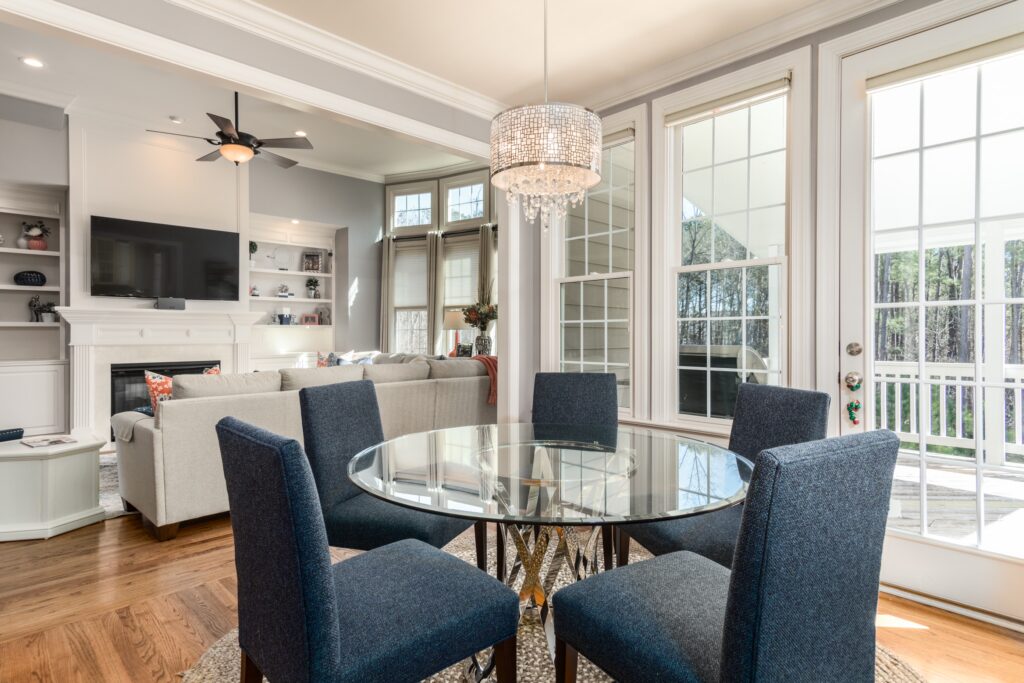Blog
What Is The Difference Between A Smart Device And A Smart Home?
Discover the difference between smart devices and smart homes. Learn how they function, connect, and are controlled. Find out their automation capabilities and scalability. Enhance your understanding of the world of smart technology.
In this article, you will explore the intriguing distinction between a smart device and a smart home. While the terms may seem interchangeable, understanding their dissimilarities is crucial for navigating the ever-expanding world of innovative technology. Join us as we delve into the unique features and capabilities of both concepts, shedding light on the fascinating contrast between a solitary intelligent gadget and a fully interconnected, automated living space. Step into the realm of smart technology and discover how it can enhance your daily life in remarkable ways.

Definition
Smart Device
A smart device is a portable electronic gadget that is connected to the internet and can perform various tasks beyond its primary function. These devices are equipped with advanced features and capabilities that enhance user experience and convenience. Examples of smart devices include smartphones, tablets, smartwatches, fitness trackers, smart TVs, and virtual assistants like Amazon Echo or Google Home.
Smart Home
On the other hand, a smart home refers to a residential setup where various devices are interconnected and centrally controlled through a home automation system. In a smart home, multiple smart devices such as lights, thermostats, door locks, security cameras, appliances, and entertainment systems work together to create an automated and efficient living space. The primary goal of a smart home is to optimize energy usage, enhance security, and provide an overall seamless experience for the occupants.
Functionality
Smart Device Functions
Smart devices are designed to offer a wide range of functions that go beyond their core purpose. For instance, smartphones not only allow you to make calls and send messages but also enable you to browse the internet, play games, take high-quality photos, and download various applications. Similarly, fitness trackers not only monitor your heart rate and steps but also provide sleep tracking, calorie tracking, and even smartphone notifications.
Smart Home Functions
In a smart home, functions are primarily centered around automation and convenience. Imagine being able to control your lighting, heating, and security systems seamlessly with just a few taps on your smartphone or through voice commands. Smart homes can be programmed to automatically adjust temperature settings based on occupancy or time of day, activate security cameras and alarms when sensors detect unusual activity, and even initiate a welcome scenario by turning on lights and playing music as you enter the house.
Examples
Smart Device Examples
Smart devices are becoming increasingly prevalent in our daily lives. Some popular examples of smart devices include:
- Smartphones: These devices are not just for calls and messages but also serve as mini-computers, allowing you to browse the web, access social media, capture high-quality photos, and run various applications.
- Smartwatches: Beyond tracking time, smartwatches offer features like fitness tracking, heart rate monitoring, sleep analysis, and even the ability to make calls and send messages without using a smartphone.
- Smart TVs: These modern televisions are internet-enabled, providing access to streaming services, online content, and apps. They can also be controlled through a smartphone or voice commands.
Smart Home Examples
Smart homes are revolutionizing the way we live by providing automation and control over various aspects of our living spaces. Here are a few examples of smart home devices:
- Smart Thermostats: These devices allow you to remotely control and schedule your home’s heating and cooling, leading to energy savings and increased comfort.
- Smart Security Systems: Smart home security systems consist of cameras, door locks, motion sensors, and alarms that can be remotely accessed and controlled for ensuring home security even when you’re away.
- Smart Lighting: With smart lighting solutions, you can adjust the brightness and color of your lights based on your preferences, as well as schedule them to turn on or off automatically, creating ambiance and saving energy.
Connectivity
Smart Device Connectivity
Smart devices rely on wireless connectivity to stay functional and connected to the internet. Most smart devices use Wi-Fi, Bluetooth, or a combination of both to establish connections with other devices or the internet. For example, smartphones and smartwatches connect to Wi-Fi networks and cellular data networks to access the internet and communicate with other devices. Bluetooth is commonly used for connecting smart devices to accessories like headphones, speakers, or smart home hubs.
Smart Home Connectivity
In a smart home, multiple devices communicate and share data with each other via various connectivity options. Wi-Fi is the primary means of connectivity for smart home devices, allowing them to connect to the home network and the internet. Additionally, smart home ecosystems may also utilize technologies like Zigbee or Z-Wave, which use low-power wireless communication protocols specifically designed for smart home applications. These connectivity options ensure seamless communication between devices, enabling a comprehensive smart home experience.

Control
Smart Device Control
Controlling smart devices is usually done through a dedicated app or a user interface built into the device itself. For instance, smartphones have touchscreens and physical buttons for navigating and controlling various functions and settings. Smartwatches often feature touchscreens or side buttons to control notifications, health tracking, and other functions. Additionally, virtual assistants like Siri or Google Assistant can be used for voice commands, providing hands-free control over compatible smart devices.
Smart Home Control
Smart homes offer centralized control over multiple devices through a single interface. This can be achieved through a smartphone app, a dedicated smart home hub, or even voice-activated virtual assistants. With a smart home hub or app, you can control and monitor all connected devices from a single location, enabling convenient operation. Moreover, voice assistants like Amazon Alexa or Google Assistant allow you to control your smart home devices through voice commands, adding further convenience and simplicity.
Automation
Smart Device Automation
While smart devices offer various functions, automation capabilities are not as extensive as in a smart home setup. However, some smart devices do provide automated features. For example, a smartwatch can automatically track your sleep and exercise, adjust screen brightness based on ambient light, or even offer proactive health reminders. Smartphones can automate tasks using built-in features or third-party apps, such as automatically silencing notifications during specified hours.
Smart Home Automation
One of the key features of a smart home is automation. Through programmable routines or schedules, a smart home can carry out tasks automatically based on predefined conditions or triggers. For instance, you can set your smart home to turn off all lights and lower the thermostat when everyone leaves the house, or have the security system automatically arm itself at a certain time each day. This level of automation enhances convenience, creates energy efficiencies, and can even improve home security.
Integration
Smart Device Integration
You can integrate smart devices, especially those from the same manufacturer or ecosystem to work together efficiently. This integration allows for seamless communication and coordination between devices, providing an enhanced user experience. For example, a fitness tracker can integrate with a smartphone to display notifications, sync health data, and provide more accurate tracking. Smartphones can also integrate with other smart devices such as smart TVs or smart speakers for a truly connected experience.
Smart Home Integration
Integrating multiple devices into a unified system and allowing them to work in harmony is what a smart home is designed to do. This integration is facilitated by a centralized smart home hub or an app that acts as the control center for all connected devices. Through integration, smart home devices can communicate with each other, share data, and perform coordinated actions. For instance, you can create a scenario where your smart lights, security cameras, and thermostat work together to create a welcoming ambiance as soon as you unlock your front door.
Cost
Smart Device Cost
The cost of smart devices can vary depending on the brand, features, and specifications. Entry-level smart devices such as basic smartwatches or low-end smartphones can be relatively affordable, starting from around $50. However, high-end flagship smartphones or feature-rich smartwatches can cost several hundred dollars. It’s important to consider the value and functionality that a smart device offers when evaluating its cost.
Smart Home Cost
Setting up a smart home involves purchasing multiple smart devices and configuring a central control system. The cost of a smart home can vary significantly depending on the size and complexity of the setup. Basic smart home setups, including smart lighting, a smart thermostat, and a security camera, can cost several hundred dollars. However, more extensive and advanced smart home setups with multiple devices and customized automation can cost several thousand dollars. It’s crucial to consider the long-term benefits, energy savings, and convenience when evaluating the cost of a smart home setup.
Scalability
Smart Device Scalability
You can easily remove smart devices from your setup based on your needs and preferences. If you want to expand your smart device collection, you can simply purchase additional devices, connect them to your existing system, and configure them accordingly. Similarly, if you no longer require a certain smart device, you can remove it from your setup without any major difficulties. This scalability allows for flexibility and customization, ensuring that your smart device experience can evolve over time.
Smart Home Scalability
You can scale a smart home up or down depending on your requirements. Whether you want to add more smart devices, integrate new functionalities, or expand automation capabilities, you can do so by gradually incorporating additional components into your existing smart home ecosystem. This scalability allows you to start with a basic setup and gradually build a comprehensive and highly customized smart home setup over time, tailoring it to meet your changing needs and preferences.
Conclusion
In summary, while both smart devices and smart homes offer functionality and convenience, they differ in scope and complexity. Smart devices are standalone gadgets that provide advanced features and functions beyond their primary purpose, whereas smart homes are integrated systems of interconnected devices that work together to create an automated living space. Smart homes offer more extensive automation, control, and connectivity options, but they also require a higher initial investment. Ultimately, whether you choose to invest in smart devices or a smart home setup depends on your needs, preferences, and long-term goals for creating a technologically advanced and efficient living environment.






